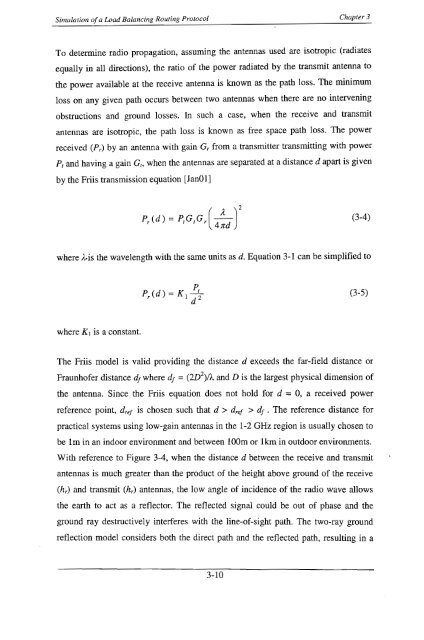Gugrajah_Yuvaan_ Ramesh_2003.pdf
Gugrajah_Yuvaan_ Ramesh_2003.pdf
Gugrajah_Yuvaan_ Ramesh_2003.pdf
You also want an ePaper? Increase the reach of your titles
YUMPU automatically turns print PDFs into web optimized ePapers that Google loves.
Simulation ofa Load Balancing Routing Protocol Chapter 3<br />
To determine radio propagation, assuming the antennas used are isotropic (radiates<br />
equally in all directions), the ratio of the power radiated by the transmit antenna to<br />
the power available at the receive antenna is known as the path loss. The minimum<br />
loss on any given path occurs between two antennas when there are no intervening<br />
obstructions and ground losses. In such a case, when the receive and transmit<br />
antennas are isotropic, the path loss is known as free space path loss. The power<br />
received (Pr) by an antenna with gain Gr from a transmitter transmitting with power<br />
Pt and having a gain G" when the antennas are separated at a distance d apart is given<br />
by the Friis transmission equation [JanOl]<br />
(3-4)<br />
where A·is the wavelength with the same units as d. Equation 3-1 can be simplified to<br />
where K I is a constant.<br />
Pt<br />
P (d) = K I -<br />
r d 2 (3-5)<br />
The Friis model is valid providing the distance d exceeds the far-field distance or<br />
Fraunhofer distance df where d f = (2D 2 )/'A and D is the largest physical dimension of<br />
the antenna. Since the Friis equation does not hold for d = 0, a received power<br />
reference point, dref is chosen such that d > dref > d f • The reference distance for<br />
practical systems using low-gain antennas in the 1-2 GHz region is usually chosen to<br />
be 1m in an indoor environment and between lOOm or 1km in outdoor environments.<br />
With reference to Figure 3-4, when the distance d between the receive and transmit<br />
antennas is much greater than the product of the height above ground of the receive<br />
(hr) and transmit (hr) antennas, the low angle of incidence of the radio wave allows<br />
the earth to act as a reflector. The reflected signal could be out of phase and the<br />
ground ray destructively interferes with the line-of-sight path. The two-ray ground<br />
reflection model considers both the direct path and the reflected path, resulting in a<br />
3-10
















